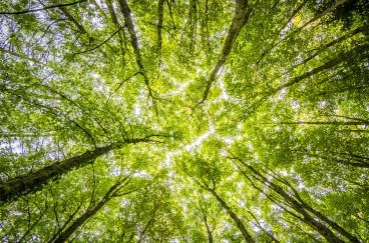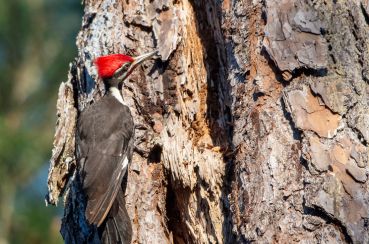
A visit to Presqu’ile Provincial Park will show considerable damage from recent storms. Winds howling off Lake Ontario have toppled many large trees, their roots torn from the ground. Park staff have been busy removing those trees that pose a danger along the roadways, in campgrounds, and trails. Volunteers from The Friends of Presqu’ile have been repairing damaged boardwalks and trails. Many of the toppled trees are Ash, weakened by the Emerald Ash Borer. Visitors frequently ask, “When will the fallen and dead trees in the forest be removed?” The answer may surprise you!
Standing dead trees, called snags, and fallen logs are a vital part of forest ecology. Both are teeming with living creatures, all dependent on one another. A perfect example of the importance of standing dead trees involves woodpeckers. We’ve all heard, and perhaps seen, a woodpecker industriously digging holes in dead trees. The woodpecker is looking for food, the insects that inhabit the dead tree. The holes dug out by the woodpeckers become nesting sites and small animal dens for squirrels, small rodents, bats, snakes, weasels and more. Over 50 larger animal species make dens in dead trees, as do thousands of insect
 species. Woodpeckers, chickadees, owls, nuthatches, and even several species of ducks use cavities in dead trees to nest.
species. Woodpeckers, chickadees, owls, nuthatches, and even several species of ducks use cavities in dead trees to nest.
Fallen logs are also full of life. They provide “room and board” for many. Insects, such as beetles live there, they attract other wildlife to feed on them. This attracts larger animals looking for their next meal. The insects and other small animals that burrow through the logs help the logs decompose, which provides much needed nutrients for the soil. Much of the soil layer at Presqu’ile is quite shallow, so these nutrients are critical to ensuring the soil is rich enough to support new seedlings.
Replenishing the Forest
The forests of Presqu’ile Provincial Park are constantly being replenished and renewed. Some trees, such as the Eastern Hemlock and Yellow Birch, release seeds that actually germinate on the rotting logs on the forest floor. Next time you are walking on one
 of the forested trails, look for the small plants growing from the logs; they will eventually become mature trees. Unfortunately, these tender plants are a favourite meal for the deer in the park.
of the forested trails, look for the small plants growing from the logs; they will eventually become mature trees. Unfortunately, these tender plants are a favourite meal for the deer in the park.
To help maintain forest health and provide native vegetation in heavily used areas, the park has its own nursery, one of the very few within the provincial parks system. Park staff collect seeds from native species of trees growing within the park. These are planted and nurtured in the nursery until they are sturdy enough to be transplanted. Each year, park staff and volunteers from The Friends of Presqu’ile Park plant approximately 600 young trees in various areas of the park to replace some of those that have fallen or died. You may notice some of the saplings are protected in white buckets—these can control moisture or protect the trees from hungry wildlife, particularly deer. Both the tree nursery and the fall tree planting operations are financially supported by the Friends of Presqu’ile Park.
Take a Self-Guided Stroll in Jobes' Woods
On your next park visit, take a stroll along Jobes' Woods Trail. It is easily accessible thanks to the boardwalk built by volunteers from The Friends of Presqu’ile Park. You will walk through an old growth forest and be able to see layers or stratification. There are four distinct layers—wildflowers and ferns on the ground; shrubs and young trees at eye level; then, small tree species and immature trees; and finally, far above your head, is the canopy of mature trees.
During this short walk, you will see examples of standing dead trees, permeated with holes to house small creatures. You will also see fallen logs and uprooted trees teeming with life. The living forest, in all its messy glory, is on full display.


